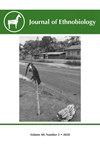我们对澳大利亚传统谷物脱粒了解多少?
IF 1.3
3区 社会学
Q1 ANTHROPOLOGY
引用次数: 0
摘要
本文回顾了澳大利亚原住民谷物脱粒的人种学描述,为今后的谷物研究和澳大利亚东南部谷物脱粒习俗的复兴提供参考。谷物的加工需要许多步骤,虽然收获、绞碎和碾磨的记录相对较多,但脱粒阶段,即在种子被绞碎和碾磨之前去除谷壳和其他非食用部分的阶段,仍然鲜为人知。在澳大利亚东南部,由于殖民化的影响,大部分脱粒知识已经失传;而澳大利亚中部的社区则保留了与传统谷物有关的脱粒知识。然而,这些物种并非在所有地区都常见。由于不同的物种需要不同的脱粒过程,只有部分知识可以直接应用于澳大利亚东南部地区。人种学描述有可能为振兴这一习俗贡献更多原住民知识。本文汇集了有关传统脱粒的人种学描述,以促进这种做法的复兴和对原住民谷物的进一步研究。本文章由计算机程序翻译,如有差异,请以英文原文为准。
What Do We Know About Threshing Traditional Grains in Australia?
This article reviews ethnographic descriptions of Australia's First Nations people's grain threshing to inform future grain research and revival of practice in south-eastern Australia. The processing of grain requires many steps, and while harvesting, winnowing and grinding are comparatively well-documented, the threshing stage, which involves the removal of the husk and other nonedible parts of the seed head before the seed is winnowed and ground, remains poorly understood. In south-eastern Australia much of the threshing knowledge has been lost through the impacts of colonization; whereas communities in Central Australia have retained this knowledge in relation to their traditional grains. However, these species are not common in all areas. As different species require different threshing processes, only some of this knowledge can be directly applied in south-eastern Australia. Ethnographic descriptions have the potential to contribute additional First Nations knowledge to the revitalization of this practice. This article brings together ethnographic descriptions of traditional threshing to facilitate the revival of practice and further native grains research.
求助全文
通过发布文献求助,成功后即可免费获取论文全文。
去求助
来源期刊

Journal of Ethnobiology
Social Sciences-Anthropology
CiteScore
4.80
自引率
3.40%
发文量
21
审稿时长
>12 weeks
期刊介绍:
JoE’s readership is as wide and diverse as ethnobiology itself, with readers spanning from both the natural and social sciences. Not surprisingly, a glance at the papers published in the Journal reveals the depth and breadth of topics, extending from studies in archaeology and the origins of agriculture, to folk classification systems, to food composition, plants, birds, mammals, fungi and everything in between.
Research areas published in JoE include but are not limited to neo- and paleo-ethnobiology, zooarchaeology, ethnobotany, ethnozoology, ethnopharmacology, ethnoecology, linguistic ethnobiology, human paleoecology, and many other related fields of study within anthropology and biology, such as taxonomy, conservation biology, ethnography, political ecology, and cognitive and cultural anthropology.
JoE does not limit itself to a single perspective, approach or discipline, but seeks to represent the full spectrum and wide diversity of the field of ethnobiology, including cognitive, symbolic, linguistic, ecological, and economic aspects of human interactions with our living world. Articles that significantly advance ethnobiological theory and/or methodology are particularly welcome, as well as studies bridging across disciplines and knowledge systems. JoE does not publish uncontextualized data such as species lists; appropriate submissions must elaborate on the ethnobiological context of findings.
 求助内容:
求助内容: 应助结果提醒方式:
应助结果提醒方式:


